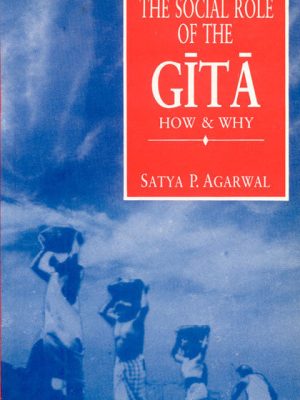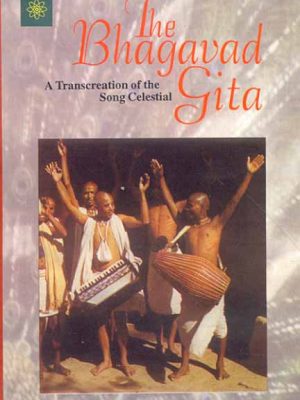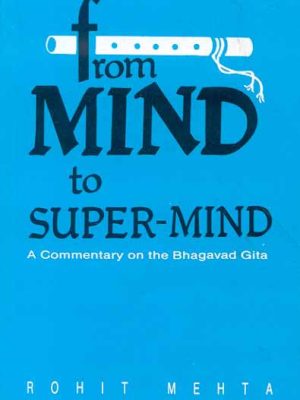Bhagavad Gita
Bhagavad Gita is a way of life. In the battle of Mahabharata, when Arjuna is unable to fight against his relatives, Shri Krishna guides him through the right path. The teachings of Shri Krishna guide not only Arjuna but the rest of humanity through every battle of life. Bhagavad Gita helps us to be a better version of ourselves. few books from this collection are Srimadbhagavadgita, Selections from the Mahabharata: Re-affirming Gita’s Call for the Good of All, and Shrimadbhagavat Ka Gyan.
-
Gita For The Twenty-First Century: Bhagavad Gita Universal Message
This latest version of Bhagavad-Gita (with slokas in Sanskrit and commentary in English) explains how the message of social service has been derived from this universal scripture. Written in a simple style, it will enable common people including high school students) to obtain a clear understanding of the teachings of the Gita so that they can work efficiently for the good of the society (and for their own good too). Keeping in mind the inter-connected nature of the various chapters of the Gita, ample cross-references are given in this book to help the readers identify the main points of this scripture’s basic message. Furthermore, a ten-point summary of this message is also made an integral part of the last chapter, in response to the feedback received from readers who had gone through an earlier draft of this book.
Review(s)
About the Author(s)
Dr. Satya P. Agarwal is a Social Scientist. His academic honours include five gold medals and numerous merit scholarships and research fellowships at various universities. The Governor of the State of Maryland conferred upon him “The Governor’s Citation”, in recognition of his pioneering books as also his contribution to social service. He is author of several books besides the present one which are widely acclaimed and appreciated by the discerning readers. Other honours conferred on him include: (i) Kunti Goyal International Award, (ii) Special Award of Manas Sangam and (iii) International Tulasi Award.
₹195.00 -
The Social Role of the Gita: How and Why
Although the Bhagavad-gita has traditionally been regarded as a poem of primarily religious significance, Dr. Agarwal shows that with the proper interpretation its message may be ransformed into a set of practical ethical guidelines. This practical aspect of the Gitaês teaching, its insistence that involvement with the world is an ethically correct function of human behaviour, is the focus of this book. That involvement with the worldês is expressed by the term ‘Lokasamgraha’. The term covers a multitude of social and political forms of behaviour and attitudes of mind and is perhaps more central to the meaning the Gita should have for modern man than its traditional other-worldly interpretation.
Dr. Agarwal has examined the various ways in which India has reacted to the impact of many powerful foreign influences over the past two centuries. He has done so by studying the lives and the activities of select Hindu thinkers who through their writings and their ways of life showed their awareness of a need to preserve an Indian identity. All of them undertook to define these differences and thus established their views on what might be acceptable alternatives for India and the Indian genius vis-a-vis those principles and customs that run counter to the Indian tradition. But they were not unanimous in either their conclusions or the strategies they devised for attaining their common goal. The author has concentrated on the role the Bhagavad-gita has played in the lives and works of these thinkers.
Review(s)
About the Author(s)
Dr. Satya P. Agarwal is a Social Scientist. His academic honours include five gold medals and numerous merit scholarships and research fellowships at various universities. The Governor of the State of Maryland conferred upon him “The Governor’s Citation”, in recognition of his pioneering books as also his contribution to social service. He is author of several books besides the present one which are widely acclaimed and appreciated by the discerning readers. Other honours conferred on him include: (i) Kunti Goyal International Award, (ii) Special Award of Manas Sangam and (iii) International Tulasi Award.
₹395.00 -
The Bhagavad Gita: A Transcreation of the song celestial
The Bhagavad Gita is one of the world’s greatest scriptures, the key sacred text of Hinduism. It means the ‘Song of God’ and is often called the ‘Song Celestial’. Alan Jacobs has succeeded in revitalizing the ancient text into a form which reveals the full majesty of the magnificent scriptures as well as its practical message for today’s seekers. The outdated English of Sir Edwin Arnold’s fine poetic translation in 1885 has been trasnsformed and given clear meaning. It has also been expanded to reinforce the poetic imagery using cotemporary free verse based on innovative metaphors. “It is like a great symphony. each chapter relates to the last but leads on to the coda.”
Review(s)
About the Author(s)
₹295.00 -
From Mind to Super Mind: A Commentary on Bhagavad Gita
The message of the Gita has an important and a practical bearing on the problems of the modern age. It shows a way out of the complexities of the mind to complete and unfettered freedom of the Super-Mind. This path is not meant only for the few, it can be trodden by all who seek freedom from life’s entanglements. In an age where the individual is becoming more and more insignificant due to the impacts of political, economic and social forces, the Gita brings to man a message of hope and cheer, for it shows a way of life which leads to the regaining of his lost significance, and the spiritual regeneration of man is indeed the way to the creation of a happy society.
About the Author:
ROHIT MEHTA was a founder of the Congress Socialist group in 1934. He travelled widely in almost all parts of the world as a lecturer speaking on Religion, Philosophy, Yoga, Psychology, Education, etc. Mehta was a founder of the congress socialist group in 1934 which later on became the socialsit party of India. But while he accepted the economics of socialist Party of India. But while he accepted the economics of socialism he was deeply dissatisfied with the philosophy of socialism. This led him to become an active worker in the Theosophical society. He became an International secretary of the society when Dr. G.S. Arundale was the president.
₹295.00 – ₹495.00From Mind to Super Mind: A Commentary on Bhagavad Gita
₹295.00 – ₹495.00 -
The Bhagavad-Gita: The Song of God: Original Sanskrit text & Roman Transliteration, A lucid english rendition,
The Gita is a song-not just any song, but a very special song, the song of God-sung by the
Divine Being of infinite consciousness to His most beloved devotee, Arjuna. Arjuna in Sanskrit means clear white light, the brightness and clarity, the name of the man who manifested the clarity of pure devotion by which the Lord’s wisdom may be heard, and by which the universal form may be perceived. And what a song it is! A symphony of soul’s longing for divinity, of the search for clarity, the explanations of yoga-what constitutes divine union, and how one gets there. No
subject of spiritual evolution remains neglected by the Gita.
The Gita has been translated into more languages than any other literary work. In English
alone there are more renditions than can be counted. Each one has its own character, each one
a slightly different analysis. Some are poetic, some philosophical, some dogmatic, some universal.
This translation by Dr. Prasad is just beautiful-so simple and clear. He uses just enough sanskrit to convey the majesty and beauty of the language and the intensity of the dialogue, and yet does not leave the reader dumbfounded in an unintelligible maze of vocabulary. The universal principle of the philosophy he espouses are filled with poetic grace and style. He captures so much of the Grace of the Gita, even in the prose of English, that the orchestrations of wisdom cannot but help lull our hearts after every chapter.
From Confusion’s first desire to neglect one’s duty or responsibilities, to the infinite vision of
the Lord as a consequence of total surrender to the will of God, Prasad’s rendering takes the
reader from doubts and misgivings to perfect efficiency in all that one undertakes.
The Bhagavad-Gita has the original Sanskrit text with Roman transliteration, and a lucid English rendition. Concise and to the point commentaries on two hundred twenty-seven selected key verses are provided. One hundred thirty three verses are printed in red to enable the first-time readers to study these verses before delving deep into the vast ocean of transcendental knowledge. The teachings of saints and sages of major religious denominations as well as world leaders and scholars have been included. Quotations from the Vedas, Puranas, Upanisads, Smrtis, Ramayana, Mahabharata, Bhakti-sutras, Brahma-sutra, Yoga-sutra, as well as other major scriptures of the world such as the Bible, Dhammapad and Koran have been incorporated to underline the basic unity of all religious thoughts and to promote the universal brotherhood of mankind. Epilogue, references, Sanskrit transliteration and pronuciation guide, glossary and index are provided. A guide to meditation, beautiful pictures and Gita Calisa are included for daily Sadhana.
Review(s)
“The Gita is a doctrine of universal truth, the Sanatana dharma, commonly known as Hinduism. It has the capacity to come down to the level of the reader and raise him to peace of mind.” – The Adyar Library Bulletin-1996 – K.K. Raja
The originally of the author/compiler lies in providing a suitable glass on all the important stanzas. While doing this, he has drawn upon authentic sources of Indian philosophy and history, and has juxtaposed quotes from the teachings of other religions. – Prabuddha Bharata Vol.102, December 1997 – Dr. Narendranath B. Patil, Mumbai
About the Author(s)
The gita is a doctrine of universal truth, the Sanatana dharma, commonly known as Hinduism. It has the capacity to come down to the level of the reader and raise him to peace of mind. (The Adyar Library Bulletin-1996) -KK. Raja, The originality of the author/compiler lies in providing a suitable gloss on all the important stanzas. While doing this, he has drawn upon authentic sources of Indian philosophy and history, and has juxtaposed quotes from the teachings of other religions. (Prabuddha Bharata, Vol 102, Dec. 1997) -Dr. Narendranath B. Patil, Mumbai.
₹295.00 -
Bhagavad Gita in 365 days: The Spiritual Essence of the Gita
Bhagavad Gita in 365 days is a brief and simplified account of the dialogue betwwen a despondent Arjuna and the clear headed sagacious lord Krishna. It extracts the essence of the Gita in an undauting and user friendly format. With skill Lata Jagtiani has condensed the verses while retaining the philosophical essence of the Gita.
A pocket size book handy for travellers it requires a read of only a minute a day time that even the busiest amongst us can spare for a life of peace. A symbolic dip in the Ganges of wisdom it is sure to be an invaluable friend for readers of bothe sexes across all faiths for anybody given to asking philosophical questions.
Review(s)
For city dwellers busy with their daily routines, work qualms and household chores commuting and always on the move; spending some time on religion and mental relaxation is a distant thought. ‘Bhagavad Gita in 365 Days is just the book for such individual
About the Author(s)
₹195.00 -
Introspections on The Gita
Review(s)
‘an interesting and thought-provoking commentary on the Gita’ – Karan Singh, eminent Indologist, author, champion of interfaith dialogue, Padma Vibhushan.
‘Lucid & Contemplative’ – Namita Gokhale, author of Paro: Dreams of Passion
About the Author(s)
₹225.00Introspections on The Gita
₹225.00






